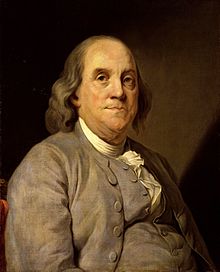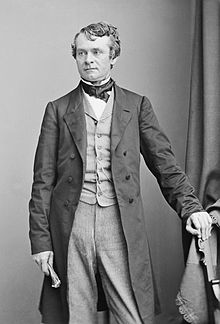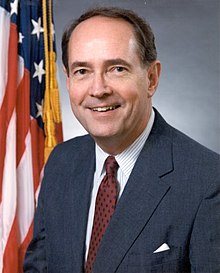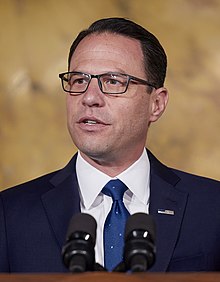List of governors of Pennsylvania
| Governor of Pennsylvania | |
|---|---|
 | |
 | |
| Residence | Governor's Residence |
| Term length | Four years, can succeed self once |
| Inaugural holder | Thomas Mifflin |
| Formation | December 21, 1790 |
| Deputy | Jim Cawley |
| Salary | $174,914 (2010)[1] |
| Website | governor.state.pa.us |
The Governor of the Commonwealth of Pennsylvania is the head of the executive branch of Pennsylvania's government[2] and the commander-in-chief of the state's military.[3]
The job of the governor is to enforce state laws and to approve or veto bills passed by the Pennsylvania Legislature.[4] The governor may grant pardons except in cases of impeachment.[5]
There have been seven presidents and 46 governors of Pennsylvania. Two governors serving non-consecutive terms. There have been a total of 55 terms in both offices. The longest term was that of the first governor, Thomas Mifflin. He served three full terms as governor and two years as president. The shortest term belonged to John Bell. He served only 19 days as acting governor after Edward Martin resigned. The current governor is Josh Shapiro. His term began on January 17, 2023.
Governors[change | change source]
Pennsylvania was one of the first thirteen colonies. It became a state on December 12, 1787.
The Presidents of the Supreme Executive Council[change | change source]

The first constitution in 1776 created the Supreme Executive Council as the executive branch. The President was the leader of the Council.[6] The president was picked each year by the council.[7]
The 1776 constitution created the position of "vice-president" but it did not say what should happen if the president left office. This happened four times. Sources from that time still listed the chief executive as the vice president when that person acted as the president. One acting president, George Bryan, has since been recognized as a governor. This is because he acted as president for over six months.
| # | President | Took office | Left office | Vice President |
|---|---|---|---|---|
| 1 | Thomas Wharton Jr. | March 5, 1777 | May 23, 1778 [note 1] |
George Bryan |
| 2 | George Bryan | May 23, 1778 | December 1, 1778 | acting as president [note 2] |
| 3 | Joseph Reed | December 1, 1778 | November 15, 1781 | George Bryan [note 3] |
| Matthew Smith [note 3] | ||||
| William Moore | ||||
| 4 | William Moore | November 15, 1781 | November 7, 1782 | James Potter |
| 5 | John Dickinson | November 7, 1782 | October 18, 1785 | James Ewing |
| James Irvine [note 3] | ||||
| Charles Biddle | ||||
| 6 | Benjamin Franklin | October 18, 1785 | November 5, 1788 | Charles Biddle |
| Peter Muhlenberg [note 3] | ||||
| David Redick | ||||
| 7 | Thomas Mifflin | November 5, 1788 | December 21, 1790 | George Ross |
Governors of the Commonwealth of Pennsylvania[change | change source]






The 1790 constitution ended the council. It replaced the president with a governor,[8] and created a three-year term for governor. This term started on the third Tuesday of the December after the election. A governors could not serve more than nine out of any twelve years.[9] The 1838 constitution moved the start of the term to the third Tuesday of the January after the election. It allowed governors to only serve six out of any nine years.[10] The 1874 constitution lengthened the term to four years. It said that governors could not succeed themselves (be elected to another term while still in office).[11] The current constitution of 1968 changed this to allow governors to serve two consecutive terms.[12] There are no limits on the number of terms a governor may serve in total as long as there is a four year break after a second term.
If the governor dies, resigns or is impeached, the lieutenant governor becomes governor for the rest of the term. If the governor becomes unable to act as governor because of disability, the lieutenant governor only acts out the duties of governor.[13] Should both offices be vacant, the president pro tempore of the state senate becomes governor.[14] The position of lieutenant governor was created in the 1874 constitution. Before this, the speaker of the senate would act as governor in cases of vacancy. At first, the lieutenant governor could only act as governor. It was not until the 1968 constitution that the lieutenant governor could actually become governor. The office of governor has been vacant for an extended period of time once. There was a 17-day time period in 1848 between the death of Francis R. Shunk and the swearing in of William F. Johnston. Governors and lieutenant governors are elected on the same ticket.[15]
Anti-Masonic (1) Democratic (13) Democratic-Republican (6) None (1) Republican (26) Whig (2)
| # | Governor | Took office | Left office | Party | Lt. Governor [note 4] |
Terms [note 5] | ||
|---|---|---|---|---|---|---|---|---|
| 1 | Thomas Mifflin | December 21, 1790 | December 17, 1799 | None [note 6] |
None | 3 [note 7] | ||
| 2 | Thomas McKean | December 17, 1799 | December 20, 1808 | Democratic- Republican |
3 | |||
| 3 | Simon Snyder | December 20, 1808 | December 16, 1817 | Democratic- Republican |
3 | |||
| 4 | William Findlay | December 16, 1817 | December 19, 1820 | Democratic- Republican |
1 | |||
| 5 | Joseph Hiester | December 19, 1820 | December 16, 1823 | Democratic- Republican |
1 | |||
| 6 | John Andrew Shulze | December 16, 1823 | December 15, 1829 | Democratic- Republican |
2 | |||
| 7 | George Wolf | December 15, 1829 | December 15, 1835 | Democratic- Republican |
2 | |||
| 8 | Joseph Ritner | December 15, 1835 | January 15, 1839 | Anti-Masonic | 1 [note 8] | |||
| 9 | David R. Porter | January 15, 1839 | January 21, 1845 | Democratic | 2 [note 9] | |||
| 10 | Francis R. Shunk | January 21, 1845 | July 9, 1848 | Democratic | 1 1⁄2 [note 10] | |||
| — | Office vacant | July 9, 1848 | July 26, 1848 | — | — [note 11] | |||
| 11 | William F. Johnston | July 26, 1848 | January 20, 1852 | Whig | 1 1⁄2 [note 12] | |||
| 12 | William Bigler | January 20, 1852 | January 16, 1855 | Democratic | 1 | |||
| 13 | James Pollock | January 16, 1855 | January 19, 1858 | Whig | 1 | |||
| 14 | William F. Packer | January 19, 1858 | January 15, 1861 | Democratic | 1 | |||
| 15 | Andrew Gregg Curtin | January 15, 1861 | January 15, 1867 | Republican | 2 | |||
| 16 | John W. Geary | January 15, 1867 | January 21, 1873 | Republican | 2 | |||
| 17 | John F. Hartranft | January 21, 1873 | January 21, 1879 | Republican | None | 2 [note 13] | ||
| John Latta | ||||||||
| 18 | Henry M. Hoyt | January 21, 1879 | January 16, 1883 | Republican | Charles Warren Stone | 1 | ||
| 19 | Robert E. Pattison | January 16, 1883 | January 18, 1887 | Democratic | Chauncey Forward Black | 1 | ||
| 20 | James A. Beaver | January 18, 1887 | January 20, 1891 | Republican | William T. Davies | 1 | ||
| 19 | Robert E. Pattison | January 20, 1891 | January 15, 1895 | Democratic | Louis Arthur Watres | 1 | ||
| 21 | Daniel H. Hastings | January 15, 1895 | January 17, 1899 | Republican | Walter Lyon | 1 | ||
| 22 | William A. Stone | January 17, 1899 | January 20, 1903 | Republican | John P. S. Gobin | 1 | ||
| 23 | Samuel W. Pennypacker | January 20, 1903 | January 15, 1907 | Republican | William M. Brown | 1 | ||
| 24 | Edwin Sydney Stuart | January 15, 1907 | January 17, 1911 | Republican | Robert S. Murphy | 1 | ||
| 25 | John K. Tener | January 17, 1911 | January 19, 1915 | Republican | John Merriman Reynolds | 1 | ||
| 26 | Martin Grove Brumbaugh | January 19, 1915 | January 21, 1919 | Republican | Frank B. McClain | 1 | ||
| 27 | William Cameron Sproul | January 21, 1919 | January 16, 1923 | Republican | Edward E. Beidleman | 1 | ||
| 28 | Gifford Pinchot | January 16, 1923 | January 18, 1927 | Republican | David J. Davis | 1 | ||
| 29 | John Stuchell Fisher | January 18, 1927 | January 20, 1931 | Republican | Arthur James | 1 | ||
| 28 | Gifford Pinchot | January 20, 1931 | January 15, 1935 | Republican | Edward C. Shannon | 1 | ||
| 30 | George Howard Earle III | January 15, 1935 | January 17, 1939 | Democratic | Thomas Kennedy | 1 | ||
| 31 | Arthur James | January 17, 1939 | January 19, 1943 | Republican | Samuel S. Lewis | 1 | ||
| 32 | Edward Martin | January 19, 1943 | January 2, 1947 | Republican | John C. Bell, Jr. | 1⁄2 [note 14] | ||
| 33 | John C. Bell, Jr. | January 2, 1947 | January 21, 1947 | Republican | vacant | 1⁄2 [note 15] | ||
| 34 | James H. Duff | January 21, 1947 | January 16, 1951 | Republican | Daniel B. Strickler | 1 | ||
| 35 | John S. Fine | January 16, 1951 | January 18, 1955 | Republican | Lloyd H. Wood | 1 | ||
| 36 | George M. Leader | January 18, 1955 | January 20, 1959 | Democratic | Roy E. Furman | 1 | ||
| 37 | David L. Lawrence | January 20, 1959 | January 15, 1963 | Democratic | John Morgan Davis | 1 | ||
| 38 | William Scranton | January 15, 1963 | January 17, 1967 | Republican | Raymond P. Shafer | 1 | ||
| 39 | Raymond P. Shafer | January 17, 1967 | January 19, 1971 | Republican | Raymond J. Broderick | 1 | ||
| 40 | Milton Shapp | January 19, 1971 | January 16, 1979 | Democratic | Ernest P. Kline | 2 [note 16] | ||
| 41 | Dick Thornburgh | January 16, 1979 | January 20, 1987 | Republican | William Scranton, III | 2 | ||
| 42 | Robert P. Casey | January 20, 1987 | January 17, 1995 | Democratic | Mark Singel | 2 [note 17] | ||
| 43 | Tom Ridge | January 17, 1995 | October 5, 2001 | Republican | Mark S. Schweiker | 1 1⁄2 [note 18] | ||
| 44 | Mark S. Schweiker | October 5, 2001 | January 21, 2003 | Republican | Robert Jubelirer | 1⁄2 [note 19] | ||
| 45 | Ed Rendell | January 21, 2003 | January 18, 2011 | Democratic | Catherine Baker Knoll[note 20] | 2 | ||
| Joe Scarnati[note 21] | ||||||||
| 46 | Tom Corbett | January 18, 2011 | January 20, 2015 | Republican | Jim Cawley | 1 | ||
| 47 | Tom Wolf | January 20, 2015 | January 17, 2023 | Democratic | Michael J. Stack III | 2 | ||
| John Fetterman | ||||||||
| 48 | Josh Shapiro | January 17, 2023 | Incumbent | Democratic | Austin Davis | 1 | ||
Living former governors[change | change source]
As of 17 January 2023[update], five former governors are alive. The most recent death of a former governor was that of Dick Thornburgh (1979–1987), on December 31, 2020.
| Name | Gubernatorial term | Date of birth |
|---|---|---|
| Tom Ridge | 1995–2001 | August 26, 1945 |
| Mark Schweiker | 2001–2003 | January 31, 1953 |
| Ed Rendell | 2003–2011 | January 5, 1944 |
| Tom Corbett | 2011−2015 | June 17, 1949 |
| Tom Wolf | 2015−2023 | November 17, 1948 |
Notes[change | change source]
- ↑ Died in office.
- ↑ As Vice President of the Supreme Executive Council, acted as president. Four vice presidents acted as president. Bryan's long term has caused his term to since be seen as being equal to president.
- ↑ 3.0 3.1 3.2 3.3 Resigned; no reason was recorded by the Supreme Executive Council.
- ↑ The office of lieutenant governor was not created until the 1873 Constitution, first being filled in 1875.
- ↑ The fractional terms of some governors are not to be understood absolutely literally; rather, they are meant to show single terms during which multiple governors served, due to resignations, deaths and the like.
- ↑ The Federalist Party nominated Mifflin, but he himself carried no party label.
- ↑ Mifflin was elected governor three times under the 1790 Constitution, having previously been elected once as President of the Supreme Executive Council.
- ↑ Ritner was the last to serve before the 1838 constitution limited governors to serving six years out of any nine years; that constitution also changed the term to commence the next January from the election, extending Ritner's term by a month.
- ↑ First governor to serve under the 1838 constitution.
- ↑ Resigned due to illness; he died of tuberculosis only 11 days later.
- ↑ Following Francis R. Shunk's resignation, an interregnum of 17 days occurred before the speaker of the state senate, William F. Johnston, was sworn in.
- ↑ As speaker of the state senate, filled unexpired term, and was subsequently elected governor in his own right.
- ↑ First governor under the 1874 constitution, which prevented governors from succeeding themselves and lengthened terms to four years. Since Hartranft was originally elected under the previous constitution, he was allowed to succeed himself. Hartranft's first term was shortened from three to two years to fit the electoral schedule of the new constitution.
- ↑ Resigned to take an elected seat in the United States Senate. While official sources state Martin resigned on January 3, most contemporary sources reported his resignation as occurring on January 2.[16][17]
- ↑ As lieutenant governor, acted as governor for unexpired term.
- ↑ First governor under the 1968 constitution, and thus eligible to succeed himself.
- ↑ On June 14, 1993, Casey transferred executive authority to Lieutenant Governor Singel, and later that day underwent a heart-liver transplant operation. Singel acted as governor until Casey resumed the powers and duties of the office six months later on December 13, 1993. Because Casey never officially resigned, Singel was only an acting governor.
- ↑ Resigned to be Director of the Office of Homeland Security.
- ↑ As lieutenant governor, filled unexpired term.
- ↑ Died in office.
- ↑ As president pro tempore of the state senate, acted as lieutenant governor.
References[change | change source]
- General
- "Governors Database: Pennsylvania". National Governors Association. National Governors Association. 2008. Archived from the original on March 16, 2011. Retrieved April 1, 2008.
- Constitutions
- "Constitution of the Commonwealth of Pennsylvania". Commonwealth of Pennsylvania. 1968. Retrieved April 21, 2008.
- "1874 Constitution of the Commonwealth of Pennsylvania" (PDF). Constitution Party of Pennsylvania. Archived from the original (PDF) on April 15, 2010. Retrieved July 13, 2010.
- "1838 Constitution of the Commonwealth of Pennsylvania" (PDF). Constitution Party of Pennsylvania. Archived from the original (PDF) on April 15, 2010. Retrieved July 13, 2010.
- "1790 Constitution of the Commonwealth of Pennsylvania" (PDF). Constitution Party of Pennsylvania. Archived from the original (PDF) on 2010-04-15. Retrieved 2008-04-21.
- "1776 Constitution of the Commonwealth of Pennsylvania" (PDF). Constitution Party of Pennsylvania. Archived from the original (PDF) on April 15, 2010. Retrieved July 13, 2010.
- Specific
- ↑ "Statutory Cost of Living Increases for Salaries of State Officials and the Heads of Departments, Boards and Commissions". State of Pennsylvania. Retrieved July 10, 2010.
- ↑ PA Constitution article IV, § 2
- ↑ PA Constitution article IV, § 7
- ↑ PA Constitution article IV, § 15
- ↑ PA Constitution article IV, § 9
- ↑ 1776 Constitution § 3
- ↑ 1776 Constitution § 19
- ↑ 1790 Constitution article II, § 1
- ↑ 1790 Constitution article IV, § 3
- ↑ 1838 Constitution article II, § 3
- ↑ 1874 Constitution article IV, § 3
- ↑ PA Constitution article IV, § 3
- ↑ PA Constitution article IV, § 13
- ↑ PA Constitution article IV, § 14
- ↑ "Executive Branch of the Several States". The Green Papers. Retrieved April 30, 2008.
- ↑ "Martin Quits Today as Penna. Governor; Bell to Take Over". Gettysburg Times. January 2, 1947. Retrieved April 30, 2008.
- ↑ Stevens, Sylvester Kirby (1964). Pennsylvania: Birthplace of a Nation. New York: Random House. pp. 375.
Other websites[change | change source]
- Office of the Governor of Pennsylvania Archived 2015-07-09 at the Wayback Machine

